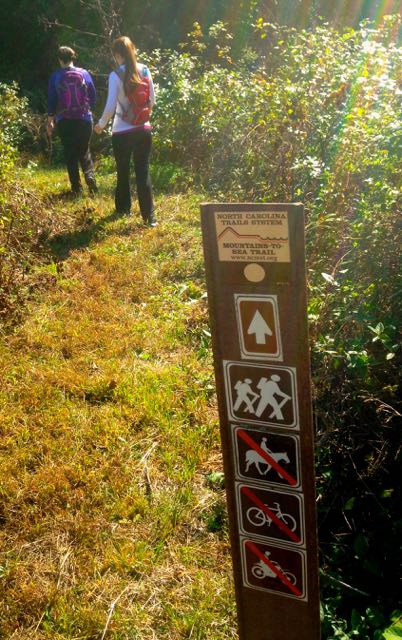 Earlier this year, the Friends of the Mountains-to-Sea Trail and N.C. State Parks announced a long-awaited route for the trail from the Triangle to the coast, the Coastal Crescent Trail, which runs for about 320 miles.
Earlier this year, the Friends of the Mountains-to-Sea Trail and N.C. State Parks announced a long-awaited route for the trail from the Triangle to the coast, the Coastal Crescent Trail, which runs for about 320 miles.In the mountains, the missing link between trail starting atop Clingman’s Dome in the Great Smoky Mountains National Park and a 300-mile stretch beginning at Waterrock Knob on the Blue Ridge Parkway, came closer to not one, but two solutions.
 At the other end of that 300 miles, where the MST departs the high country at Stone Mountain State Park, the all-volunteer Elkin Valley Trails Association built 3.5 miles of trail — including a pedestrian bridge in Elkin — in its effort to link Stone Mountain with Pilot Mountain State Park. An additional eight miles could be added by the end of 2015.
At the other end of that 300 miles, where the MST departs the high country at Stone Mountain State Park, the all-volunteer Elkin Valley Trails Association built 3.5 miles of trail — including a pedestrian bridge in Elkin — in its effort to link Stone Mountain with Pilot Mountain State Park. An additional eight miles could be added by the end of 2015.In Hillsborough in the Piedmont, the 1.8-mile Riverwalk portion of the MST opened, and recent grant approval means a crucial foot-bridge across the Eno River brings Hillsborough a step closer to being united with 107 miles of MST between Orange County and Clayton.
“I feel that we’re at the tipping point,” says Friends of the Mountains-to-Sea Trail Executive Director Kate Dixon. Her comment reflects both progress on the ground and public awareness of the trail, such as February’s standing-room-only annual meeting at Elon College.
“The annual meeting used to only be attended by volunteers,” says Dixon. “Now, we’re getting a lot of tourism types.”
Today, we highlight developments on the Coastal Crescent portion of the MST. Thursday, we’ll be back with updates on the rest of the MST.
The Coastal Crescent
About 620 miles of the 1,150-mile MST, bridging Clingman’s Dome on the Tennessee line with Jockey’s Ridge at the coast, are complete in trail form. The vast majority of that total lies from the Triangle west.
In January, the Friends of the Mountains-to-Sea Trail and N.C. State Parks jointly announced a new route for the MST east of the Triangle, the southerly Coastal Crescent Trail. Actually, “new” route isn’t entirely accurate.
Since its inception in the 1970s, the plan was for the MST to follow the Neuse River to the coast. But the vast majority of land along that corridor is privately owned, and a goodly amount is in floodplain: at any one time large portions of the trail could be submerged. So a few years ago, the Friends of the MST began pursing a southerly route, largely to take advantage of the greater amounts of public land — from state parks to N.C. Wildlife Resources Commission game lands to nature preserves and set-asides — in the region.

They came up with a route — the route unveiled in January — that Dixon is excited about.
However, she adds: “State Parks still believes the Neuse is a viable option.” (Which makes this a good place to explain the curious circumstance of the MST. Technically, it’s a state park. But it’s development has been spearheaded by the nearly all-volunteer efforts of the Friends of the Mountains-to-Sea Trail. The two entities have a good working relationship.
“If the Neuse Trail happens, great,” says Dixon. “But we’ll continue with the Coastal Crescent.” The worst that can happen: the MST winds up with two good options to the coast. (In fact, the Neuse option will happen either way; plans are advancing to make the Neuse River a paddle trail for the MST.)
What gets Dixon excited about the Coastal Crescent?
“The whole area is full of amazing historical sites,” she says. The Penderlea Community, for instance, conceived in the 1930s as a homesteading program under the New Deal. Or Watha, where “The Secret Life of Bees” was filmed. There’s a Rosenwald School along the way, and a stretch of trail that hopefully will take advantage of an old dike system on the Cape Fear River operated by the U.S. Army Corps of Engineers.
Of the 320-mile route, Dixon says about 80 miles is natural surface trail, the rest is on country roads. (The longest continuous stretch of natural surface trail is 19 miles, on forest roads in the Holly Shelter Game Lands.) An additional 60 to 70 miles could be added within 10 years.
But the Coastal Crescent is well worth exploring now, says Dixon, “because of all the history and great little towns, and the country roads,” says Dixon. “A lot of the trail is ideal for bike tours.”
 The Coastal Crescent is divided into four sections; learn more about each section by clicking on the links. Also, check out this guide to the trail compiled by the Friends of the Mountains-to-Sea Trail.
The Coastal Crescent is divided into four sections; learn more about each section by clicking on the links. Also, check out this guide to the trail compiled by the Friends of the Mountains-to-Sea Trail.
- Segment 12B: Agricultural Heartland: Howell Woods to Suggs Mill Pond.
- Segment 13B: Carolina Bay Country: Suggs Mill Pond to Singletary Lake State Park.
- Segment 14B: Land of History: Singletary Lake State Park to Holly Shelter Game Land.
- Segment 15B: The Onslow Bight and Jacksonville: Holly Shelter Game Land to Stella.
For MST developments from the Triangle to Clingman’s Dome, check this post.

Look for additional coverage of the MST and MST Month at GetGoingNC.com.
